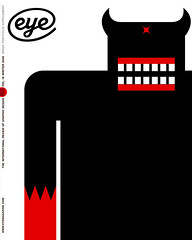Winter 2006
Andre’s mug: inspiring prank, global brand… or a one-hit wonder?
Supply and Demand: The Art of Shepard Fairey
By Shepard Fairey, Roger Gastman, Steven Heller, Carlo McCormick, Helen Stickler, Kevin Taylor and Rob Walker<br>Gingko Press / Obey Giant, £35<br><br>The hard-sell intro to Supply and Demand will, no doubt, have many digging into their pockets, eager for the promise of this hefty tome. Carlo McCormick writes: ‘A ringmaster in the circus of signs, Fairey makes meaning jump through flaming hoops, hucksters like a true carnie the tinctures of an impossible cure, and stomps his way through the public spectacle like a herd of elephants coming to town.’
For £35 the hard-backed monograph delivers 360 pages and a generous proportion of colour illustrations that span the high-wire exploits of Shepard Fairey, street artist and father of the phenomenal Obey Giant. Hopping between contributions from writers including Roger Gastman and Steven Heller, Fairey divides and reflects upon his work under headings such as ‘Propaganda’ and ‘Surveillance’, before completing with his ‘Commercial Work’. Of course, one could argue that ultimately all of his work is commercial, since Fairey has made a decent brand of himself with many advertisers keen to make it to his corner of the street.
Fairey begins, however with his defining venture: the conception of Andre the Giant. It is an inspiring account of how a student prank elevated a dead French wrestler into a counter-cultural brand icon, and all this while securing a little theoretical validation from Heidegger. Illustrations capture various stages of development as Andre evolves – under the influence of Barbara Kruger – into the ubiquitous Obey Giant. Fairey follows with an extensive photographic archive of his campaigns, congested spreads recording audacious ‘bombs’ and ‘hits’ staged across a variety of global cityscapes. Written accounts of the rooftop chases, the imprisonments and the police brutality – something of a rarity in the art and design section of most bookshops – confirm Fairey as one willing to suffer for his brand.
Yet there is more to this project than bravery and cheek. The success of the Obey campaign can be credited to the ambiguity, the supposed emptiness of the Obey Giant image. Who are we to obey? And why? Placed within a western, urban consumerist context, it inevitably implies brand manipulation. Yet in a Communist-controlled environment – such as Hong Kong – it could operate quite differently. As a form of intervention, the saturated repetition of the Obey face is a dazzling achievement. As the instigator, Fairey revels in a certain vacuity, freed from the responsibility of delivering a coherent singular message. But is he really making meaning ‘jump through flaming hoops’?
As the Obey campaign rolls on Fairey calls on a number of iconic figures – Lenin, Castro, Mao and Stalin – to support the idea of ‘propaganda’. Drawing from historical sources, the posters acquire greater sophistication yet lose the engaging emptiness of the original Obey face. The ‘non-message’ washed away in a flood of familiar signs for ‘revolution’. The enthusiasm for celebrity endorsement continues in the following chapter as Fairey drafts in a collection of freedom fighters and dictators. Bold, vectorised portraits of the Black Panthers, Angela Davis and Emiliano Zapata find themselves bundled in with Richard Nixon and Ming the Merciless.
A later collection of delicate mixed-media tributes to Strummer, Marley,
Seale and Chomsky reveal a growing dexterity, but cannot disguise a broad-brush approach to his content. In his written contributions, Fairey is confident that these pieces act as platforms for ongoing dialogue and questioning. But suspicion grows that his heroes have replaced his ideas.
Perhaps one of the few examples of a genuine dialogue and questioning occurs when a graffiti artist defaces his posters of Che Guevara, accusing him of capitalising on other people’s cultures. The prickly subject of exploitation re-emerges as Fairey introduces the Giant Fab Four (Andre replacing George in a collection culled from John Kelley’s White Album portraits). He admits to ‘another example of my piggybacking onto the cultural cache of something and benefiting from it, but I don’t feel guilty about it because that’s the currency out there and there are lots of exchanges of currency’. But unfortunately Fairey seems to be trading down. As with his freedom fighters and revolutionaries, he is unable to re-ignite their original moment, and so each of these celebrity portraits become what Fredric Jameson refers to as a ‘blank parody, a statue with blind eyeballs’.
As a street artist and a graphic designer, Fairey is technically very good at what he does and his work at times attains a genuine beauty. But he is not as important as this large publication would suggest. Aside from the success of the Obey campaign, his prodigious output lacks the rage of Jamie Reid or the wit and popular touch of Banksy. And so the ‘ringmaster in the circus of signs’ never really shows up. Instead he is replaced by a highly polished tribute act with a back-catalogue of favourites from counter-culture.
Steve Rigley, designer, educator, Glasgow
First published in Eye no. 62 vol. 16 2006
Eye is the world’s most beautiful and collectable graphic design journal, published quarterly for professional designers, students and anyone interested in critical, informed writing about graphic design and visual culture. It is available from all good design bookshops and online at the Eye shop, where you can buy subscriptions and single issues.

